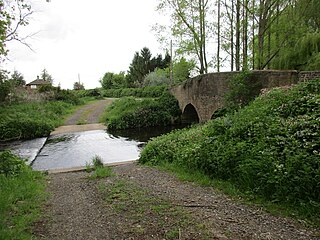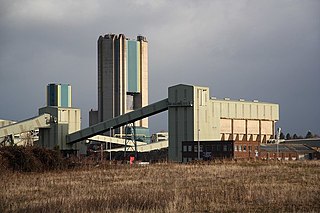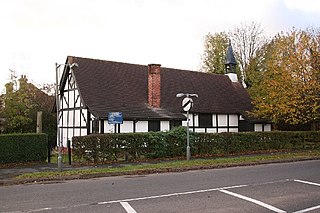
Blyth is a village and civil parish in the Bassetlaw district of the county of Nottinghamshire, in the East Midlands, north west of East Retford, on the River Ryton. The population of the civil parish as of the 2011 census was 1,233, and this increased to 1,265 in 2021. It sits at a junction with the A1, and the end of the motorway section from Doncaster.

Worksop is a market town in the Bassetlaw District in Nottinghamshire, England. It is located 15 miles (24 km) south of Doncaster, 15 miles (24 km) south-east of Sheffield and 24 miles (39 km) north of Nottingham. Located close to Nottinghamshire's borders with South Yorkshire and Derbyshire, it is on the River Ryton and not far from the northern edge of Sherwood Forest. Other nearby towns include Chesterfield, Gainsborough, Mansfield and Retford. The population of the town was recorded at 44,733 in the 2021 Census.

Firbeck is a village and civil parish in the Metropolitan Borough of Rotherham in South Yorkshire, England, on the border with Nottinghamshire. It lies between Maltby and Oldcotes, off the A634 and B6463 roads. Firbeck had a population of 317 in 2001, which had fallen to 299 at the 2011 Census.

The River Ryton is a tributary of the River Idle. It rises close to the Chesterfield Canal near Kiveton Park, and is joined by a series of tributaries near Lindrick Common in the Metropolitan Borough of Rotherham, South Yorkshire, England. Most of its course is in Nottinghamshire, flowing through the town of Worksop. It meanders northwards to join the River Idle near the town of Bawtry on the South Yorkshire-Nottinghamshire border.

Bassetlaw is a parliamentary constituency in Nottinghamshire, represented in the House of Commons of the UK Parliament since the 2024 general election by Jo White, a Labour Party candidate. Before the 2019 general election, the seat had been part of the so-called "red wall", being held by the Labour Party since 1935 before falling to the Conservative Party.

Barnby Moor is a village and civil parish in the Bassetlaw district of Nottinghamshire, England, with a population of 257, increasing to the 2011 Census to 278, and dropping marginally to 274 in 2021. The village is about three miles north of Retford.

Bassetlaw was a wapentake in the English county of Nottinghamshire. The wapentake covered an area in the north of the county, roughly equivalent to the modern Bassetlaw local government district. The wapentake was divided into the divisions of Hatfield, North Clay and South Clay.
Oldcotes is a village in Nottinghamshire, England. It is in the civil parish of Styrrup with Oldcotes. The village is centred on the crossroads of the A60 and A634 roads, five miles south east of Maltby.

Harworth Colliery was a colliery near the town of Harworth Bircotes in Bassetlaw, Nottinghamshire, England.

Hodsock Priory is an English country house in Hodsock, Nottinghamshire, 4 miles (6.4 km) north of Worksop, England, and 1 mile (1.6 km) south of Blyth. Despite its name, it is not and never has been a priory. Hodsock is renowned for its snowdrops in early spring. It is also a venue for special events and weddings.

Langold is a village in the civil parish of Hodsock, in the Bassetlaw district, north Nottinghamshire, England. At the 2011 census it was defined as a ward of Bassetlaw Council with a population of 2,472. It was built to provide housing for the miners of Firbeck Colliery between 1923 and 1927. Langold Lakes Country Park is situated on the south-western edge of the village.

Carlton in Lindrick is a village and civil parish about 3 miles (5 km) north of Worksop in Nottinghamshire, England. The 2011 Census recorded a parish population of 5,623, including nearby Wallingwells. The 2021 Census reported alone on Carlton in Lindrick, with 5,635 residents.

Hermeston Hall is a manor house near to the villages of Oldcotes and Langold, and within the parish or Hodsock, northwestern Nottinghamshire, England. It is located in a lane just off the A60 road, just south of the village of Oldcotes on the road to Langold.

Styrrup is a village in the civil parish of Styrrup with Oldcotes on the B6463 road in the Bassetlaw district, in the English county of Nottinghamshire. The population of the civil parish at the 2021 census was 731, an increase from the 685 of 2011. It is near the small town of Harworth. The village is surrounded by farmland and is approximately 1 mile from the A1 road intersection at Blyth. The housing consists primarily of modern properties constructed in the 1970s and numerous barn conversions arranged off the Main Street. The local pub, The White Swan, has been demolished and replaced by modern housing.

Oldcotes Dyke is the name of the final section of a river system that drains parts of north Nottinghamshire and the Metropolitan Borough of Rotherham in South Yorkshire, England. Historically, it has supported milling, with seven water mills drawing their power from its water, and ran through the grounds of the Cistercian Roche Abbey. It is a tributary of the River Ryton.

Styrrup with Oldcotes is a civil parish in the Bassetlaw district, within the county of Nottinghamshire, England. The overall area had a population of 731 at the 2021 census, an increase from 684 at the 2011 census. The parish lies in the north of the county. It is 31 miles north of Nottingham, and 15 miles east of Sheffield. The parish rests alongside the county border with South Yorkshire.

Clumber and Hardwick is a civil parish in the Bassetlaw district, in the county of Nottinghamshire, England. The parish includes the settlement of Hardwick Village and Clumber Park, a country park. In the UK census of 2021 the parish had a population of 66. The parish lies in the north west of the county, and south west within the district. It is 125 miles north west of London, 22 miles north of the city of Nottingham, and 3½ miles south east of the market town of Worksop.The parish touches Babworth, Carburton, Elkesley, Perlethorpe cum Budby and Welbeck. The parish was formed on 1 April 1994. The area is within Sherwood Forest and has close historical associations with the Dukes of Newcastle, being part of a wider region known as The Dukeries. There are 26 listed buildings in Clumber and Hardwick.

Scofton is a hamlet in the Bassetlaw district of northern Nottinghamshire, England. It is 130 miles (210 km) north west of London, 25 miles (40 km) north of the county town and city of Nottingham, and 3 miles (4.8 km) east of the nearest town Worksop. Having a shared modern history with nearby Osberton Hall, it is sometimes referred to as Scofton-with-Osberton. Other close neighbours are Bilby and Rayton which also have historical associations.



















